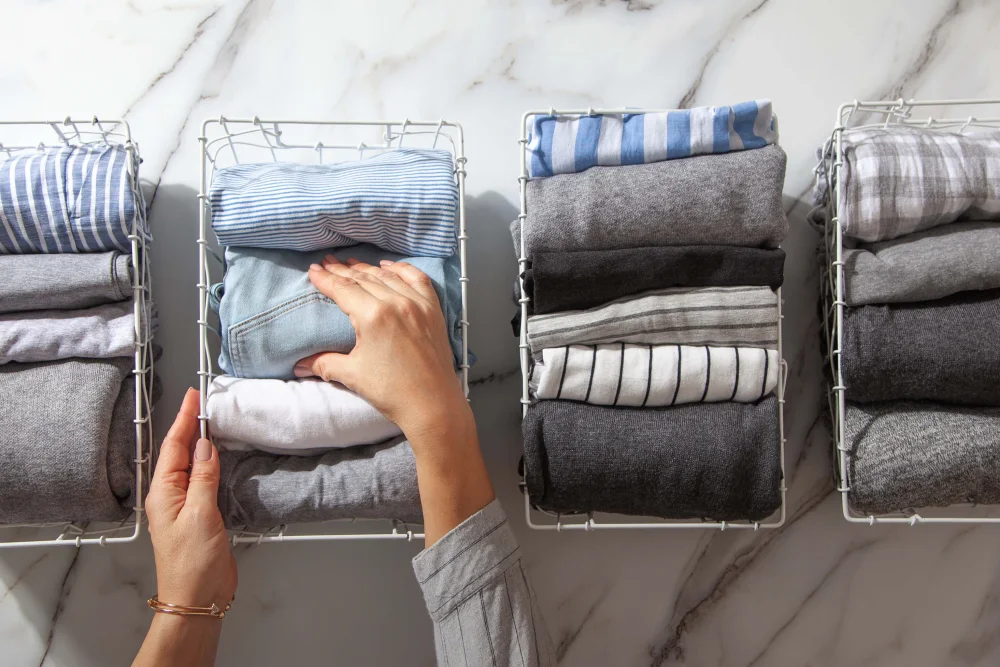
Make Room in Your Closet with Self Storage
November 2, 2021 | Home Organization
Colder seasons are coming, and with them comes a chill in the air that will have many reaching for boots and comfy sweaters to bundle up in. The excitement of fall activities also brings the retirement of summer staples until warmer months make their return.
Instead of cramming unworn items under your bed or maneuvering around boxes of out-of-season clothing, utilize self storage to maximize closet space while keeping your items looking their best.
This Metro Storage Guide will help with the organization and transition of your wardrobe and provide a much-needed refresh until that floppy hat and sundress are ready for poolside gatherings once again.
Categorize Your Clothes
Begin your transition process by organizing your closet into three categories: warm weather, cold weather, and year-round items. Having separate sections will allow you to quickly rotate items from your closet to your storage unit and back again.
Warm weather items may include sun hats, dresses, swimwear, and sandals. Cold weather clothing examples are boots, jackets and coats, snow gear, and thick pants. Items that can be layered are considered year-round items such as t-shirts, light sweaters, jeans, and dress clothing. These items should be kept in the closet along with clothing made of delicate materials such as lace, cashmere, or embroidered pieces to preserve their integrity.
Items you can always reach for, regardless of the season, should have a permanent spot in your closet. Clothing made of delicate materials such as lace, cashmere or embroidered pieces should join them as well. While you may not be able to wear these year-round, you’ll have more control over the space they’re stored in.
How to Best Pack Your Clothes
To reduce the risk of mold, mildew, and pests damaging your items, opt for plastic storage bins with tight-fitting lids instead of cardboard boxes if possible. Clear bins will help easily identify contents while colored totes can provide a more uniform look. If you go for bins that aren’t see-through, choose bins with a small viewing panel or use labels to quickly organize without needing to open every box each time.
Certain items do best in bins while others benefit from being hung up. For a simple hanging option, use cardboard wardrobe boxes. Available at most home improvement stores and moving companies, these boxes have front access and a metal hanging bar that replicates the one in your closet. These allow for a seamless transition of clothes from your closet, into the box, and off to your storage unit.
Here’s a quick guide to determine where to pack each item:
DO hang:
- Blazers
- Blouses
- Dresses
- Dress pants
These are items that are more wrinkle-prone or may lose their shape when folded into a box. If you need quick, easy access to your hanging items or prefer to see what’s inside, a covered rolling clothing rack might be the best option for you. Clothing racks can’t be stacked but can offer longer bars for more clothing and wheels to help with easy transport.
Conversely, some items can lose their shape when being hung up. Bulky sweaters, for example, can stretch and sag due to their weight, making them unwearable by the time they’re retrieved.
DO NOT hang:
- Delicates
- Denim pants and khakis
- Stretchy items
- Sweaters
- T-shirts
Vacuum sealed bags can help compress items if you’re tight on space, but be mindful of which pieces you choose to include. Delicate fabrics such as fur, wool or leather and fluffy items like insulated coats can be crushed and have trouble reverting back to their original shape.
Prepare For the Transition
As you’re packing away clothing for the season, take time to clean each item and check for snags, holes, and missing buttons or zippers. Invisible stains can oxidize and become permanent, creating a not-so-pleasant surprise when it’s time for your award-winning holiday sweater to make its return.
Shoes deserve time and attention too. Check for worn soles and wipe down or polish each pair and utilize shoe trees and toe shapers to make sure shoes keep their shape.
Downsize Your Wardrobe
You can also use this time to pare down your wardrobe and get rid of items that don’t fit or haven’t been worn in a while. Set up a donation box during your first clean out and again during each transition. You’ll be able to save time by having fewer non-essential pieces to go through and get to pass on some of your lightly worn items to others.
Storage for the Changing Season
Metro Self Storage is excited for you to feel the results of your closet refresh and get your space back!
If you’ve followed our guide, you’re ready to say goodbye to the times of over-packed boxes under your bed and hello to a new season of trends, with room to fully embrace them, too. Proudly serving 14 states, we have plenty of storage options including climate-controlled units to help protect your favorite pieces from extreme temperatures and humidity.
Not sure which unit will work best for your seasonal transitions? Refer to our size guide for help or give us a call.
Whether you just need room for your clothing or are looking to store your boat and lake essentials as well, we have the space for you—rent or reserve your unit today!



